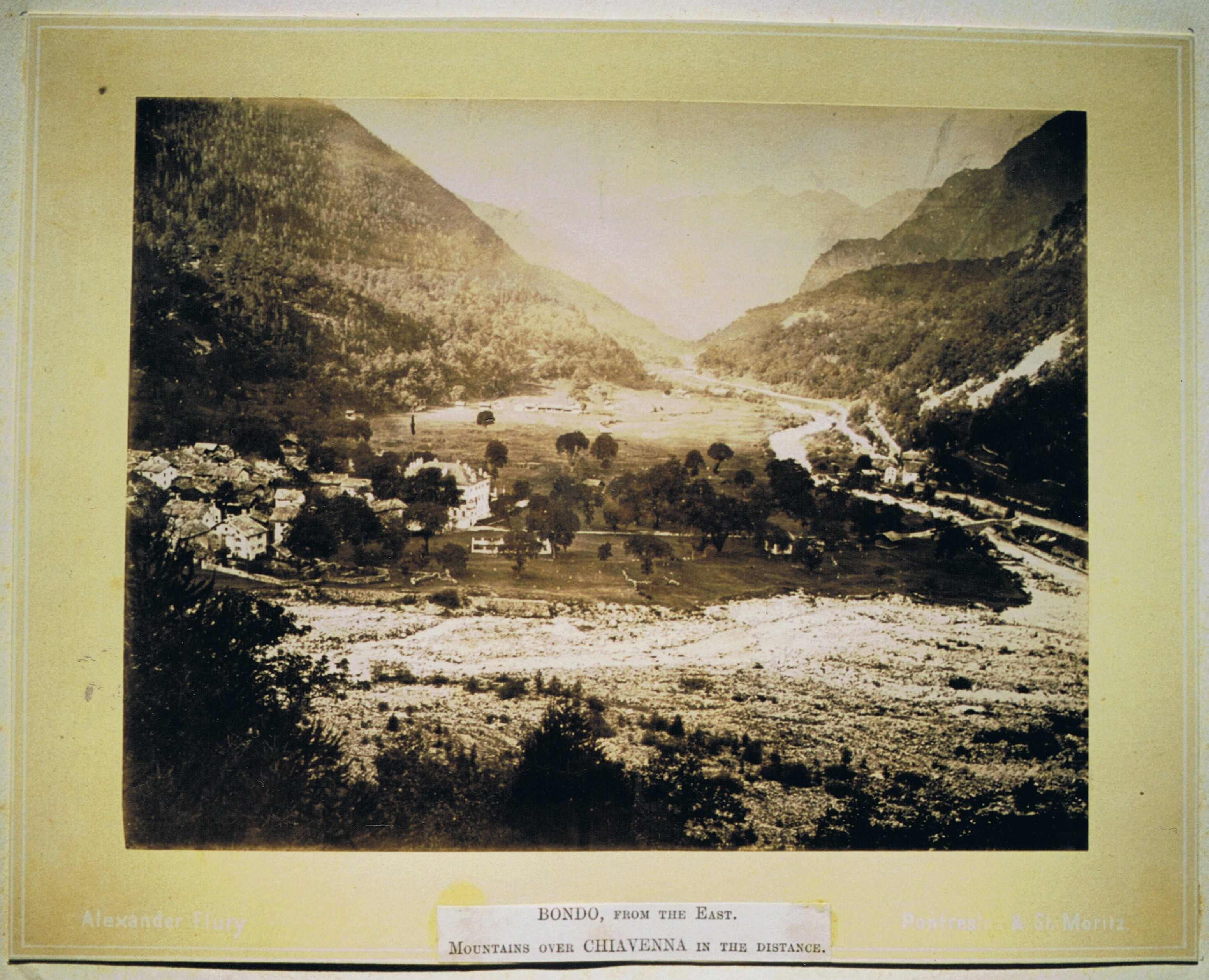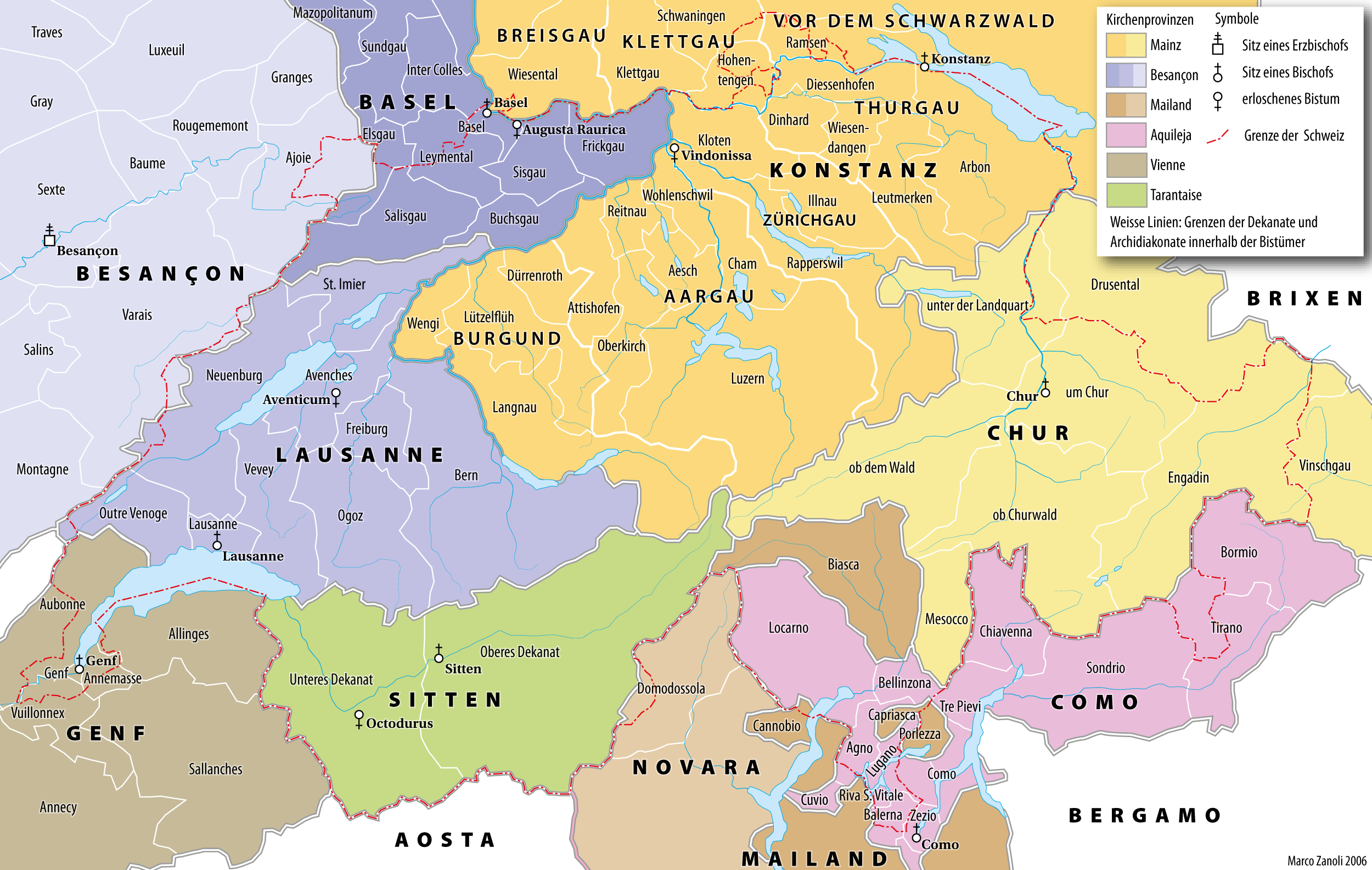|
Gotteshausbund
The League of God's House (German language, German: ''Gotteshausbund'', Italian language, Italian: ''Lega Caddea'', rm, ) was formed in what is now Switzerland on 29 January 1367, to resist the rising power of the Bishopric of Chur and the House of Habsburg. The League allied with the Grey League and the League of the Ten Jurisdictions in 1471 to form the Three Leagues. The League of God's House, together with the two other Leagues, was allied with the Old Swiss Confederacy throughout the 15th and 16th centuries. After the Napoleonic wars the League of God's House became a part of the Swiss canton of Graubünden. Before the League The region that would become the League of God's House has always been heavily influenced by the Roman Catholic Diocese of Chur, Diocese of Chur. The Bishop of Chur is first mentioned in 451 when its Bishop St. Asimo attended the Synod of Milan, but probably existed a century earlier. During the 5th and 6th centuries there is evidence of an extensive R ... [...More Info...] [...Related Items...] OR: [Wikipedia] [Google] [Baidu] |
Three Leagues
The Three Leagues, sometimes referred to as Raetia, was the alliance of 1471 of the League of God's House, the League of the Ten Jurisdictions, and the Grey League, leading eventually to the formation of the Swiss canton of Graubünden (Grisons). The territory corresponds to the core territory of Raetia Curiensis (ruled by the bishops of Chur as Prince-Bishopric of Chur), the early medieval remnant of the Roman province of Raetia prima. League of God's House On 29 January 1367, the League of God's House (german: Gotteshausbund, it, Lega Caddea, rm, ), was founded to resist the rising power of the Bishopric of Chur and the House of Habsburg. Bishop Peter Gelyto reacted by transferring the bishopric to the Habsburgs in exchange for a pension from the ducal house. The instrument of union was signed by envoys of the cathedral chapter, the episcopal Ministerialis, the city of Chur and the districts of Domleschg, Schams, Oberhalbstein, Oberengadin, Unterengadin and Bergell. ... [...More Info...] [...Related Items...] OR: [Wikipedia] [Google] [Baidu] |
Old Swiss Confederacy
The Old Swiss Confederacy or Swiss Confederacy (German language, Modern German: ; historically , after the Swiss Reformation, Reformation also , "Confederation of the Swiss") was a loose confederation of independent small states (, German or In the charters of the 14th century described as "communities" (, ), the German term ''Orte'' becomes common in the early 15th century, used alongside "estate" after the Reformation. The French term is used in Fribourg in 1475, and after 1490 is increasingly used in French and Italian documents. It only enters occasional German usage after 1648, and only gains official status as synonym of with the Act of Mediation of 1803. ), initially within the Holy Roman Empire. It is the precursor of the modern state of Switzerland. It formed during the 14th century, from a foundation of the Old Swiss Confederacy, nucleus in what is now Central Switzerland, growth of the Old Swiss Confederacy, expanding to include the cities of Zürich and Bern by ... [...More Info...] [...Related Items...] OR: [Wikipedia] [Google] [Baidu] |
Helvetic Republic
The Helvetic Republic (, , ) was a sister republic of France that existed between 1798 and 1803, during the French Revolutionary Wars. It was created following the French invasion and the consequent dissolution of the Old Swiss Confederacy, marking the end of the ''ancien régime'' in Switzerland. Throughout its existence, the republic incorporated most of the territory of modern Switzerland, excluding the cantons of Geneva and Neuchâtel and the old Prince-Bishopric of Basel. The Swiss Confederacy, which until then had consisted of self-governing cantons united by a loose military alliance (and ruling over subject territories such as Vaud), was invaded by the French Revolutionary Army and turned into an ally known as the "Helvetic Republic". The interference with localism and traditional liberties was deeply resented, although some modernizing reforms took place. Resistance was strongest in the more traditional Catholic cantons, with armed uprisings breaking out in spring 1 ... [...More Info...] [...Related Items...] OR: [Wikipedia] [Google] [Baidu] |
Bregaglia (Kreis) Wappen
Bregaglia ( Italian and rm, ) is a municipality in the Maloja Region in the canton of Grisons in Switzerland. It was formed by the 2010 merger of the municipalities of Bondo, Castasegna, Soglio, Stampa and Vicosoprano, all located in the Val Bregaglia. Bregaglia is the only Italian-speaking municipality in Switzerland in which the majority of the population is Protestant. History Bondo Under the Carolingian dynasty Bondo belonged to the ''Ministerium Bergallia'', which was a dependant of the early Bishops of Chur, though after 960 it was owned directly by the Bishop. The valley church of S. Maria at Castelmur is first mentioned in 988, while the village church for Bondo, S. Martino, was consecrated in 1250. During the High Middle Ages Bondo was part of several villages that were collectively known as ''di là dell'acqua'' (‘across the water’), which were part of the district of Sotto Porta/ Unterporta. In 1367 Bondo, together with the rest of Sotto Porta/U ... [...More Info...] [...Related Items...] OR: [Wikipedia] [Google] [Baidu] |
Chur
, neighboring_municipalities= Arosa, Churwalden, Tschiertschen-Praden, Domat/Ems, Felsberg, Malix, Trimmis, Untervaz, Pfäfers , twintowns = Bad Homburg (Germany), Cabourg (France), Mayrhofen (Austria), Mondorf-les-Bains (Luxembourg), Terracina (Italy) '' Chur (, locally ; it, Coira ; rm, label= Sursilvan, Cuera ; rm, label=Vallader, Cuoira ; rm, label= Puter and Rumantsch Grischun, Cuira ; rm, label=Surmiran, Coira; rm, label= Sutsilvan, Cuera or ; french: Coire ) la, CVRIA, and . is the capital and largest town of the Swiss canton of the Grisons and lies in the Grisonian Rhine Valley, where the Rhine turns towards the north, in the northern part of the canton. The city, which is located on the right bank of the Rhine, is reputedly the oldest town of Switzerland. The official language of Chur is German,In this context, the term "German" is used as an umbrella term for any variety of German. A person is allowed to communicate with the authorities by using any ... [...More Info...] [...Related Items...] OR: [Wikipedia] [Google] [Baidu] |
Chur Wappen
'' Chur (, locally ; it, Coira ; rm, label=Sursilvan, Cuera ; rm, label= Vallader, Cuoira ; rm, label= Puter and Rumantsch Grischun, Cuira ; rm, label= Surmiran, Coira; rm, label=Sutsilvan, Cuera or ; french: Coire ) la, CVRIA, and . is the capital and largest town of the Swiss canton of the Grisons and lies in the Grisonian Rhine Valley, where the Rhine turns towards the north, in the northern part of the canton. The city, which is located on the right bank of the Rhine, is reputedly the oldest town of Switzerland. The official language of Chur is German,In this context, the term "German" is used as an umbrella term for any variety of German. A person is allowed to communicate with the authorities by using any kind of German, in written or oral form. However, the authorities will always use Swiss Standard German (the Swiss variety of Standard German) in documents, or any written form. In spoken interaction, ''Hochdeutsch'' (Swiss Standard German or what the particular sp ... [...More Info...] [...Related Items...] OR: [Wikipedia] [Google] [Baidu] |
Bishopric Of Chur
The Prince-Bishopric of Chur (german: Hochstift Chur, Fürstbistum Chur, Bistum Chur) was an ecclesiastical principality of the Holy Roman Empire, and had Imperial immediacy. The Prince-Bishopric of Chur controlled contiguous land from the city of Chur, to Engadin, and to Vinschgau. The historical State must be distinguished from the Roman Catholic Diocese of Chur which still exists, even if the bishop was the same man. They were leaded by the League of God's House from the 15th century. The Three Leagues then took over any effettive power from the Prince-Bishopric (while in Vinschgau the control passed to the Habsburg), and after the Reformation the bishop's estates remained the sole territory of the principality. The bishop had the vote number 51 in the Imperial Diet. History The Bishopric of Chur was first founded in 451, when Asinio was made Bishop of Chur. In 1170, Emperor Frederick I raised the Bishopric of Chur to the title of Prince-Bishopric of Chur. In October 1621, ... [...More Info...] [...Related Items...] OR: [Wikipedia] [Google] [Baidu] |
Napoleonic Wars
The Napoleonic Wars (1803–1815) were a series of major global conflicts pitting the French Empire and its allies, led by Napoleon I, against a fluctuating array of European states formed into various coalitions. It produced a period of French domination over most of continental Europe. The wars stemmed from the unresolved disputes associated with the French Revolution and the French Revolutionary Wars consisting of the War of the First Coalition (1792–1797) and the War of the Second Coalition (1798–1802). The Napoleonic Wars are often described as five conflicts, each termed after the coalition that fought Napoleon: the Third Coalition (1803–1806), the Fourth (1806–1807), the Fifth (1809), the Sixth (1813–1814), and the Seventh (1815) plus the Peninsular War (1807–1814) and the French invasion of Russia (1812). Napoleon, upon ascending to First Consul of France in 1799, had inherited a republic in chaos; he subsequently created a state with stable financ ... [...More Info...] [...Related Items...] OR: [Wikipedia] [Google] [Baidu] |
Roman Catholic Diocese Of Chur
The Diocese of Chur is a Latin Church ecclesiastical territory or diocese of the Catholic Church in Switzerland. It extends over the Swiss Cantons of Graubünden (Grisons), Schwyz, Glarus, Zurich, Nidwalden, Obwalden and Uri. The modern Catholic diocese must be distinguished from the historical Prince-Bishopric of Chur, a state of the Holy Roman Empire. History A Bishop of Chur is first mentioned in 451/ 452 when its Bishop Saint Asimo attended the Synod of Milan, but probably existed a century earlier. The see was at first suffragan to the Archbishop of Milan, but after the Treaty of Verdun (843) it became suffragan to Mainz. In consequence of political changes it became in 1803 immediately subject to the Holy See. According to local traditions, the first Bishop of Chur was Saint Lucius, who is said to have died a martyr at Chur around the year 176 and whose relics are preserved in the cathedral. St. Lucius is venerated as the principal patron of the diocese. The country ha ... [...More Info...] [...Related Items...] OR: [Wikipedia] [Google] [Baidu] |
Synod Of Milan
The Synod of Milan or Council of Milan may refer to any of several synods which occurred in late Roman Mediolanum or medieval Milan in northern Italy's Po valley: Synod of 345 In 353 or 354, Pope Liberius wrote thus: ''"Eight years ago the Eusebian deputies, Eudoxius and Martyrius (who came to the West with the formula gr, μακρόστικος), refused to anathematize the Arian doctrine at Milan"''. But the Synod of Milan here alluded to is placed about the year 345, soon after the Synod of Sardica. St. Maximinus was at this synod. Synod of 355 Lucifer of Cagliari was deputed by Pope Liberius, with the priest Pancratius and the deacon Hilary, to request the Emperor Constantius to convene a council, to deal with the accusations directed against St. Athanasius and his previous condemnation. This council was convened at Milan in the newly erected Basilica Nova (or Basilica Maior or St. Tecla). The council however did not follow the hopes of the Pope due to the overwhel ... [...More Info...] [...Related Items...] OR: [Wikipedia] [Google] [Baidu] |
Bishop Of Chur
The Bishop of Chur (German: ''Bischof von Chur'') is the ordinary of the Roman Catholic Diocese of Chur, Grisons, Switzerland (Latin: ''Dioecesis Curiensis'')."Diocese of Chur" ''''. David M. Cheney. Retrieved February 29, 2016"Diocese of Chur" ''GCatholic.org''. Gabriel Chow. Retrieved February 29, 2016 History A Bishop of Chur is first mentioned in 451/452 when Asinius attended the |




.jpg)


